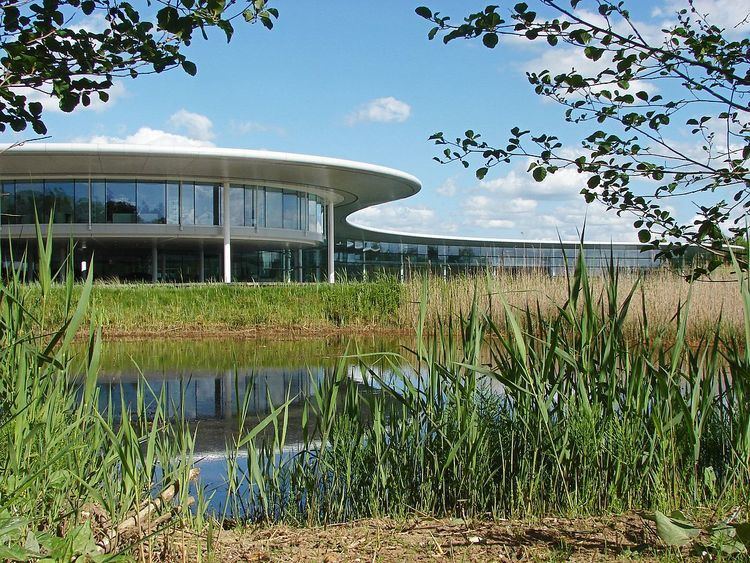Inaugurated 12 May 2004 Opened 12 May 2004 Architect Norman Foster | ||
 | ||
Alternative names Full Name: The McLaren Technology and Production Centre Current tenants McLaren Technology Group (Technology Centre)McLaren Automotive (Production Centre)Glaxosmithkline (Centre for Applied Technologies) Construction started 1999 (Second phase of building began in 2010) Completed 2003 (Second phase of building completed in 2011) Hours Closed now Thursday8:30AM–6PMFriday8:30AM–6PMSaturday9AM–4:30PMSundayClosedMonday8:30AM–6PMTuesday8:30AM–6PMWednesday8:30AM–6PM Similar Dunton Technical Centre, Willis Building, Longbridge plant, Sainsbury Centre for Visual Arts, Ford Dagenham | ||
Inside the mclaren technology centre driven
The McLaren Technology Centre is the headquarters of the McLaren Technology Group Ltd and all of its companies, located on a 500,000 m² site in Woking, Surrey, England. The complex consists of four buildings, two of which are open. The main building is the McLaren Technology Centre (Home of McLaren Group). The others are The McLaren Production Centre (Home of McLaren Automotive), the McLaren-GSK Centre for Applied Performance (Home of McLaren-GSK Parthership) and the McLaren Centre for Applied Technologies (Home of McLaren Applied Technologies).
Contents
- Inside the mclaren technology centre driven
- Jenson button tour around mclaren technology centre bbc interview
- Buildings
- Features
- History
- References
The main headquarters building is a large, roughly semi-circular, glass-walled building, designed by the architect Norman Foster and his company, Foster and Partners. The building was short-listed for the 2005 Stirling Prize, which was won by the Scottish Parliament building. About 1,000 people work at the Technology Centre. It is home to the McLaren Racing Formula One constructor and McLaren Automotive, the makers of the Mercedes-Benz SLR McLaren, as well as other companies of the McLaren Group. It is also the main setting of McLaren's new cartoon, Tooned.
In 2011, the size of the centre was doubled after a second building, the McLaren Production Centre, was built. This two storey building is used for manufacturing cars for McLaren Automotive and also for some of McLaren Applied Technology's products. Two more buildings are planned for the site to complete the complex, the McLaren Applied Technology Centre and the McLaren-GSK Technology Centre. These will sit beside the semi circular McLaren Technology Centre headquarters and the McLaren Production Centre.
Jenson button tour around mclaren technology centre bbc interview
Buildings
Features
The building is accompanied by a series of artificial lakes: one formal lake directly opposite that completes the circle of the building, and a further four 'ecology' lakes. Together they contain about 50,000 m³ of water. This water is pumped through a series of heat exchangers to cool the building and to dissipate the heat produced by the wind tunnels. The main working space of the building is split into 18 metre wide sections known as 'fingers' that are separated by six metre wide corridors known as 'streets'. Facilities for employees include a 700-seat restaurant, a juice and coffee bar, a swimming pool and a fitness centre. An underground Visitor and Learning Centre is connected to the main building by a walkway.
A 145 metre long, rectangular-circuit shaped wind tunnel is located at one end of the building. Team McLaren uses it for testing and development of aerodynamic parts, as well as testing aerodynamic set-ups. The tunnel contains 400 tonnes of steel and the air is propelled by a four metre wide fan that rotates at up to 600 rpm.
The Technology Centre is intended to consolidate all aspects of the McLaren Group at one site, instead of the 18 separate sites they were at before. Ron Dennis, chairman, CEO and part owner of the Group, is confident that the Technology Centre will attract the very best designers and engineers.
History
Work on the project, originally known as the Paragon Technology Centre, started in 1999 and about 4,000 construction workers were involved in what the Financial Times said "[was] claimed to be the biggest privately funded construction project in Europe." In February 2000, DaimlerChrysler purchased 40 percent of the McLaren Group and McLaren subsequently announced it would build the Mercedes-Benz SLR McLaren at the new facility.
Dennis explained one of his rationales for the project in 2000: "Put a man in a dark room, he's hot, it smells bad, versus a guy in a cool room, well-lit, smells nice... When you throw a decision at those two individuals, who's going to be better equipped to effect good judgment and make a good decision?"
McLaren employees started using the facility in May 2003. McLaren has not disclosed the project's cost, but BBC News has suggested a figure of GB£300m.
A second facility, the McLaren Production Centre has been built opposite the building in 2011, it serves as the production site of McLaren Automotive's road cars, including the MP4-12C.
